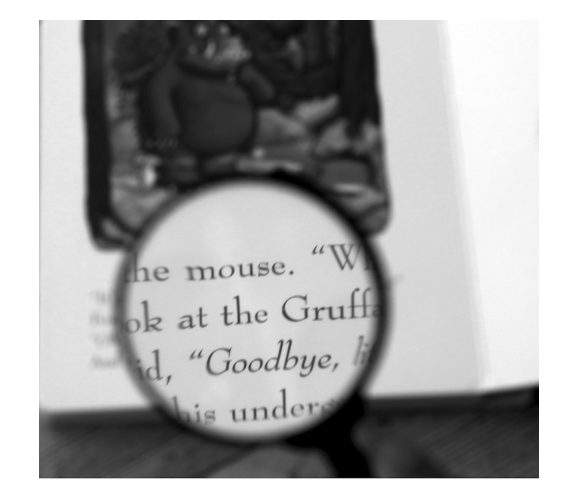3.6: Lupas
( \newcommand{\kernel}{\mathrm{null}\,}\)
Una lupa provoca una imagen en la retina que es más grande que sin la lupa. En principio, la imagen en la retina se puede aumentar simplemente acercando el objeto al ojo (reducir|so| en fijosi). Pero no|so| puede ser menor que el punto cercanodo, que tomamos aquí para ser25 cm. Es deseable utilizar una lente que haga una imagen aumentada erecta a una distancia del ojo mayor quedo. Esto se puede lograr mediante una lente positiva con el objeto más cerca de la lente que el primer punto focal, produciendo así una imagen virtual ampliada. Un ejemplo se da en la Figura3.6.1.

3.5.1 Potencia de aumento
La potencia de aumento MP o aumento angularMa se define como la relación entre el tamaño de la imagen retiniana obtenida con el instrumento y el tamaño de la imagen retiniana vista a simple vista a distancia de visión normaldo. Para estimar el tamaño de la imagen retiniana, comparamos en ambos casos donde el rayo principal a través de la parte superior del objeto y el centro de la pupila del ojo golpea la retina. Dado que la distancia entre el cristalino del ojo y la retina es fija, la relación del tamaño de la imagen en la retina para el ojo con y sin lupa es:MP=αaαu, dóndeαa yαu están los ángulos entre el eje óptico y los rayos principales para los ayudados y los a simple vista, respectivamente, como se muestra en la Figura3.6.2. Trabajar con estos ángulos en lugar de distancias es especialmente útil cuando la imagen virtual de la lupa está en el infinito. Usandoαa≈yi/L yαu≈y0/d0 conyi yy0 positivo yL la distancia positiva de la imagen al ojo (con como requisito:L≥do), encontramosMP=yid0y0L. Desdesi<0 yfo<0 tenemos,yiyo=siso=1+sifo, donde usamos la ecuación de lente para la lupa. Tenemossi=−|si|=−(L−ℓ), dondeC esta la distancia entre la lupa y el ojo. De ahí,\(( 3.6.2)\) se convierteMP=d0L[1+L−ι|fo|]=d0L[1+D(L−ι)], en: dóndeD está el poder de la lupa.

1. ℓ=|fo|: el poder de aumento es entoncesMP=d0D.
2. ℓ=0: por lo tanto,L=d0 es más pequeño mientras que MP es máximo:
MP|ℓ=0,L=d0=d0D+1
3. El objeto está en el punto focal de la lupa(s0=fo), de manera que la imagen virtual está en el infinito(L=∞) y por lo tanto
MP|L=∞=d0D,para cada distancial entre el ojo y la lupa. Los rayos son paralelos, de manera que el ojo ve el objeto de manera relajada. Este es el uso más común de la lupa.
En la prácticad0D=do/|fo| es mucho mayor que 1, por lo que MP es similar en los tres casos.
3.5.2 Nomenclatura
Normalmente las lupas se expresan en términos de la potencia de aumento cuandoL=∞ (caso 3 anterior). Por ejemplo, una lupa con una potencia de 10 Dioptrías tiene un MP igual a2.5 o2.5×. En otras palabras, la imagen es2.5 veces más grande de lo que sería si el objeto estuviera en el punto cercano del ojo sin ayuda.

